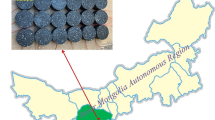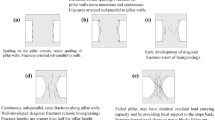Abstract
Coal and gas outburst disasters in coal seams are becoming more serious as coal mines extend deeper underground in China. Damage evolution has affected gas flow in coal seam greatly, which also controls gas permeation and gas extraction results, and finally, it has tremendous influence on prevention and control of gas disaster accidents. In this paper, the cracking process of coal under compressive stress condition and the permeability variation during the whole process is experimentally studied with the aid of 3D acoustic emission monitoring system. The experimental results suggest that the coal failure and degradation of mechanical properties are essentially related to the propagation and coalescence of induced cracks. Using a damage tensor defined by the direction-dependent crack density, the damage evolution during the whole loading process is studied. It is revealed that the damage evolution is mainly initiated with the appearance of microcracks and accelerated in the post-peak region. During the post-peak region, a similar increase tendency of damage and permeability is noticed, and therefore, a post-peak permeability model is proposed considering the influence of damage evolution on the permeability variation in the post-peak region. Finally, we analyze the gas outburst hazard with coal mining. There exists a transition zone around the vertical stress concentration, and energetic failure may result in this transition zone.





Similar content being viewed by others
References
Aguado MBD, Gonzalez Nicieza C (2007) Control and prevention of gas outbursts in coal mines, Riosa–Olloniego coalfield Spain. Int J Coal Geol 69(4):253–266
Beamish BB, Crosdale PJ (1998) Instantaneous outbursts in underground coal mines: an overview and association with coal type. Int J Coal Geol 35(1):27–55
Bieniawski ZT (1968) The effect of specimen size on compressive strength of coal. Int J Rock Mech Min Sci Geomech Abstr 5(4):325–335
Cai M, Kaiser PK, Tasaka Y, Maejima T, Morioka H, Minami M (2004) Generalized crack initiation and crack damage stress thresholds of brittle rock masses near underground excavations. Int J Rock Mech Min Sci 41:833–847
Cui X, Bustin RM (2005) Volumetric strain associated with methane desorption and its impact on coalbed gas production from deep coal seams. AAPG Bull 89(9):1181–1202
Das MN (1986) Influence of width/height ratio on post–failure behaviour of coal. Int J Min Geol Eng 4(1):79–87
Geiger L (1912) Probability method for the determination of earthquake epicenters from the arrival time only. Saint Louis Univ Bull 8:60–71
Gentzis T, Deisman N, Chalaturnyk RJ (2007) Geomechanical properties and permeability of coals from the Foothills and Mountain regions of western Canada. Int J Coal Geol 69(3):153–164
Gilman A, Beckie R (2000) Flow of coal-bed methane to a gallery. Transp Porous Media 41(1):1–16
Harpalani S (1985) Gas Flow through Stressed Coal. PhD thesis, University of California, Berkeley
Harpalani S, Chen G (1997) Influence of gas production induced volumetric strain on permeability of coal. Geotech Geol Eng 15:303–325
Harpalani S, Schraufnagel RA (1990) Shrinkage of coal matrix with release of gas and its impact on permeability of coal. Fuel 69:551–556
Hayakawa K, Murakami S (1997) Thermodynamical modeling of elastic–plastic damage and experimental validation of damage potential. Int J Damage Mech 6:333–363
Hobbs DW (1964) The strength and the stress–strain characteristics of coal in triaxial compression. J Geol 72:214–231
Huang B, Liu C, Fu J, Guan H (2011) Hydraulic fracturing after water pressure control blasting for increased fracturing. Int J Rock Mech Min Sci 48(6):976–983
Ju J (1990) Isotropic and anisotropic damage variables in continuum damage mechanics. J Eng Mech 116(12):2764–2770
Kachanov M (1994) Elastic solids with many cracks and related problems. Adv Appl Mech 30:256–426
Kaiser PK, Maloney SM (1982) Deformation properties of a sub–bituminous coal mass. Int J Rock Mech Min Sci 19:247–252
Karacan CO (2007) Development and application of reservoir models and artificial neural networks for optimizing ventilation air requirements in development mining of coal seams. Int J Coal Geol 72(3):221–239
Karacan CO, Ruiz FA, Cote M, Phipps S (2011) Coal mine methane: a review of capture and utilization practices with benefits to mining safety and to greenhouse gas reduction. Int J Coal Geol 86(2):121–156
Li D (2014) Mining thin sub-layer as self-protective coal seam to reduce the danger of coal and gas outburst. Nat Hazards 71(1):41–52
Liu J, Chen Z, Elsworth D, Miao X, Mao X (2010) Linking gas-sorption induced changes in coal permeability to directional strains through a modulus reduction ratio. Int J Coal Geol 83(1):21–30
Liu J, Chen Z, Elsworth D, Qu H, Chen D (2011) Interactions of multiple processes during CBM extraction: a critical review. Int J Coal Geol 87:175–189
Lu T, Zhao Z, Hu H (2011) Improving the gate road development rate and reducing outburst occurrences using the waterjet technique in high gas content outburst–prone soft coal seam. Int J Rock Mech Min Sci 48(8):1271–1282
Lu S, Cheng Y, Ma J, Zhang Y (2014) Application of in-seam directional drilling technology for gas drainage with benefits to gas outburst control and greenhouse gas reductions in Daning coal mine, China. Nat Hazards 73(3):1419–1437
Lubarda VA, Krajcinovic D (1993) Damage tensors and the crack density distribution. Int J Solids Struct 30(20):2859–2877
Medhurst TP, Brown ET (1998) A study of the mechanical behaviour of coal for pillar design. Int J Rock Mech Min Sci 35(8):1087–1105
Meng J, Nie B, Zhao B, Ma Y (2015) Study on law of raw coal seepage during loading process at different gas pressures. Int J Min Sci Technol 25(1):31–35
Okubo S, Fukui K, Qi Q (2006) Uniaxial compression and tension tests of anthracite and loading rate dependence of peak strength. Int J Coal Geol 68(3):196–204
Palmer I, Mansoori J (1998) How permeability depends on stress and pore pressure in coalbeds: a new model. SPE Reservoir Eval Eng 12:539–544
Pan RK, Cheng YP, Yuan L, Yu MG, Dong J (2014) Effect of bedding structural diversity of coal on permeability evolution and gas disasters control with coal mining. Nat Hazards 73(2):531–546
Pensee V, Kondo D, Dormieux L (2002) Micromechanicla analysis of anisotropic damage in brittle materials. J Eng Mech 128(8):889–897
Pini R, Ottiger S, Burlini L, Storti G, Mazzotti M (2009) Role of adsorption and swelling on the dynamics of gas injection in coal. J Geophys Res Atmos 114:B04203
Scholtes L, Donz F-V, Khanal M (2009) Scale effects on strength of geomaterials, case study: coal. J Mech Phys Solids 59:1131–1146
Seidle JR, Huitt LG (1995) Experimental measurement of coal matrix shrinkage due to gas desorption and implications for cleat permeability increases. In: Proceedings of the international meeting on petroleum engineering, Beijing, pp 14–17, paper SPE30010
Shao JF, Chau KT, Feng XT (2006) Modeling of anisotropic damage and creep deformation in brittle rocks. Int J Rock Mech Min Sci 43:582–592
Siriwardane H, Haljasmaa I, McLendon R, Irdi G, Soong Y, Bromhal G (2009) Influence of carbon dioxide on coal permeability determined by pressure transient methods. Int J Coal Geol 77:109–118
Wang S, Elsworth D, Liu J (2011) Permeability evolution in fractured coal: the roles of fracture geometry and water–content. Int J Coal Geol 87:13–25
Wang S, Elsworth D, Liu J (2013) Permeability evolution during progressive deformation of intact coal and implications for instability in underground coal seams. Int J Rock Mech Min Sci 58:34–45
Wang C, Wang C, Wei M, Gong B, Tan Y (2014) Deformation transition of intact coal induced by gas injection. Int J Min Sci Technol 24(6):833–838
Xia T, Zhou F, Liu J, Gao F (2014) Evaluation of the pre-drained coal seam gas quality. Fuel 130:296–305
Yang Q, Li Z, Tham LG (2001) An explicit expression of the second-order fabric tensor dependent elastic compliance tensor. Mech Res Commun 28(3):255–260
Yu Y, Bai J, Wang X, Wang J, Xue S, Xu K (2014) High-resistance controlled yielding supporting technique in deep-well oil shale roadways. Int J Min Sci Technol 24(2):229–236
Acknowledgments
The authors are grateful to the financial support from the National Natural Science Foundation of China (No. 2011CB201205) and the Jiangsu Creative and Innovation fund for 2014 team projects.
Author information
Authors and Affiliations
Corresponding author
Rights and permissions
About this article
Cite this article
Xue, Y., Gao, F. & Liu, X. Effect of damage evolution of coal on permeability variation and analysis of gas outburst hazard with coal mining. Nat Hazards 79, 999–1013 (2015). https://doi.org/10.1007/s11069-015-1888-2
Received:
Accepted:
Published:
Issue Date:
DOI: https://doi.org/10.1007/s11069-015-1888-2




